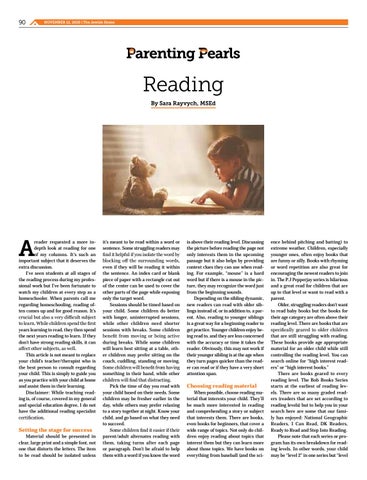90 54
NOVEMBER 12, 2020 | The Jewish Home OCTOBER 29, 2015 | The Jewish Home
Parenting Pearls
Reading By Sara Rayvych, MSEd
A
reader requested a more indepth look at reading for one of my columns. It’s such an important subject that it deserves the extra discussion. I’ve seen students at all stages of the reading process during my professional work but I’ve been fortunate to watch my children at every step as a homeschooler. When parents call me regarding homeschooling, reading often comes up and for good reason. It’s crucial but also a very difficult subject to learn. While children spend the first years learning to read, they then spend the next years reading to learn. If they don’t have strong reading skills, it can affect other subjects, as well. This article is not meant to replace your child’s teacher/therapist who is the best person to consult regarding your child. This is simply to guide you as you practice with your child at home and assist them in their learning. Disclaimer: While teaching reading is, of course, covered in my general and special education degree, I do not have the additional reading specialist certification.
Setting the stage for success Material should be presented in clear, large print and a simple font, not one that distorts the letters. The item to be read should be isolated unless
it’s meant to be read within a word or sentence. Some struggling readers may find it helpful if you isolate the word by blocking off the surrounding words, even if they will be reading it within the sentence. An index card or blank piece of paper with a rectangle cut out of the center can be used to cover the other parts of the page while exposing only the target word. Sessions should be timed based on your child. Some children do better with longer, uninterrupted sessions, while other children need shorter sessions with breaks. Some children benefit from moving or being active during breaks. While some children will learn best sitting at a table, other children may prefer sitting on the couch, cuddling, standing or moving. Some children will benefit from having something in their hand, while other children will find that distracting. Pick the time of day you read with your child based on their needs. Some children may be fresher earlier in the day, while others may prefer relaxing to a story together at night. Know your child, and go based on what they need to succeed. Some children find it easier if their parent/adult alternates reading with them, taking turns after each page or paragraph. Don’t be afraid to help them with a word if you know the word
is above their reading level. Discussing the picture before reading the page not only interests them in the upcoming passage but it also helps by providing context clues they can use when reading. For example, “mouse” is a hard word but if there is a mouse in the picture, they may recognize the word just from the beginning sounds. Depending on the sibling dynamic, new readers can read with older siblings instead of, or in addition to, a parent. Also, reading to younger siblings is a great way for a beginning reader to get practice. Younger children enjoy being read to, and they are less concerned with the accuracy or time it takes the reader. Obviously, this may not work if their younger sibling is at the age when they turn pages quicker than the reader can read or if they have a very short attention span.
Choosing reading material When possible, choose reading material that interests your child. They’ll be much more interested in reading and comprehending a story or subject that interests them. There are books, even books for beginners, that cover a wide range of topics. Not only do children enjoy reading about topics that interest them but they can learn more about those topics. We have books on everything from baseball (and the sci-
ence behind pitching and batting) to extreme weather. Children, especially younger ones, often enjoy books that are funny or silly. Books with rhyming or word repetition are also great for encouraging the newest readers to join in. The P.J Pepperjay series is hilarious and a great read for children that are up to that level or want to read with a parent. Older, struggling readers don’t want to read baby books but the books for their age category are often above their reading level. There are books that are specifically geared to older children that are still struggling with reading. These books provide age appropriate material for an older child while still controlling the reading level. You can search online for “high interest readers” or “high interest books.” There are books geared to every reading level. The Bob Books Series starts at the earliest of reading levels. There are so many graded readers (readers that are set according to reading levels) but to help you in your search here are some that our family has enjoyed: National Geographic Readers, I Can Read, DK Readers, Ready to Read and Step Into Reading. Please note that each series or program has its own breakdown for reading levels. In other words, your child may be “level 2” in one series but “level
























